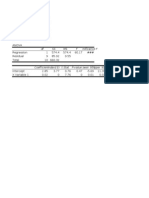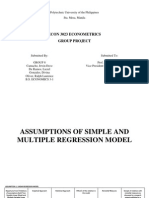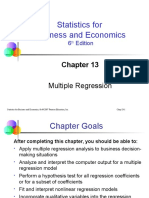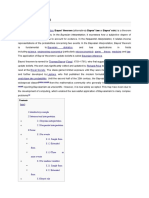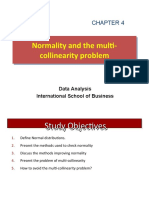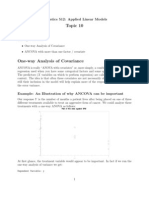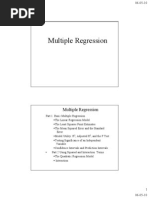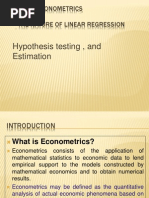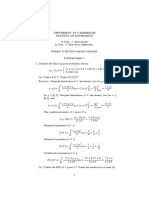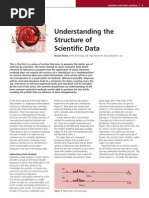Chapter 14, Multiple Regression Using Dummy Variables
Uploaded by
Amin HaleebChapter 14, Multiple Regression Using Dummy Variables
Uploaded by
Amin HaleebCh.
14: The Multiple Regression Model
building
Idea: Examine the linear relationship between
1 dependent (Y) & 2 or more independent variables (X
i
)
X X X Y
ki k 2i 2 1i 1 0 i
+ + + + + =
Multiple Regression Model with k Independent Variables:
Y-intercept
Population slopes Random Error
The coefficients of the multiple regression model
are estimated using sample data with k
independent variables
Interpretation of the Slopes: (referred to as a Net
Regression Coefficient)
b
1
=The change in the mean of Y per unit change in X
1
,
taking into account the effect of X
2
(or net of X
2
)
b
0
Y intercept. It is the same as simple regression.
ki k 2i 2 1i 1 0 i
X b X b X b b Y
+ + + + =
Estimated
(or predicted)
value of Y
Estimated slope coefficients
Estimated
intercept
Three dimension
Y
X
1
X
2
Graph of a Two-Variable Model
2 2 1 1 0
X b X b b Y
+ + =
Example:
Simple Regression Results
Multiple Regression Results
Check the size and significance level of the
coefficients, the F-value, the R-Square, etc. You
will see what the net of effects are.
Coefficients Standard Error t Stat
Intercept (b
0
) 165.0333581 16.50316094 10.000106
Lotsize (b
1
)
6.931792143 2.203156234 3.1463008
F-Value 9.89
Adjusted R Square 0.108
Standard Error 36.34
Coefficients Standard Error t Stat
Intercept 59.32299284 20.20765695 2.935669
Lotsize 3.580936283 1.794731507 1.995249
Rooms 18.25064446 2.681400117 6.806386
F-Value 31.23
Adjusted R Square 0.453
Standard Error 28.47
Using The Equation to Make Predictions
Predict the appraised value at average lot size
(7.24) and average number of rooms (7.12).
What is the total effect from 2000 sf increase in lot
size and 2 additional rooms?
$215,180 or 215.18
) 18.25(7.12 (7.24) 3.58 59.32 . App.Val
=
+ + =
$43,660
(18.25)(2) 0) (3.58)(200
value app. in Increse
=
+ =
Coefficient of Multiple Determination, r
2
and Adjusted r
2
Reports the proportion of total variation in Y
explained by all X variables taken together (the
model)
Adjusted r
2
r
2
never decreases when a new X variable is added to the
model
This can be a disadvantage when comparing models
squares of sum total
squares of sum regression
SST
SSR
r
2
k .. 12 . Y
= =
What is the net effect of adding a new variable?
We lose a degree of freedom when a new X variable is added
Did the new X variable add enough explanatory power to offset
the loss of one degree of freedom?
Shows the proportion of variation in Y explained
by all X variables adjusted for the number of X
variables used
(where n = sample size, k = number of independent variables)
Penalize excessive use of unimportant independent
variables
Smaller than r
2
Useful in comparing among models
(
|
.
|
\
|
=
1 k n
1 n
) r 1 ( 1 r
2
k .. 12 . Y
2
adj
Multiple Regression Assumptions
Assumptions:
The errors are normally distributed
Errors have a constant variance
The model errors are independent
Errors (residuals) from the regression model:
e
i
= (Y
i
Y
i
)
These residual plots are used in multiple
regression:
Residuals vs. Y
i
Residuals vs. X
1i
Residuals vs. X
2i
Residuals vs. time (if time series data)
Two variable model
Y
X
1
X
2
2 2 1 1 0
X b X b b Y
+ + =
Y
i
Y
i
<
x
2i
x
1i
The best fit equation, Y ,
is found by minimizing the
sum of squared errors, Ee
2
<
Sample
observation
Residual = e
i
= (Y
i
Y
i
)
<
Are Individual Variables Significant?
Use t-tests of individual variable slopes
Shows if there is a linear relationship between the
variable X
i
and Y; Hypotheses:
H
0
:
i
= 0 (no linear relationship)
H
1
:
i
0 (linear relationship does exist between X
i
and Y)
Test Statistic:
Confidence interval for the population slope
i
i
b
i
1 k n
S
0 b
t
=
i
b 1 k n i
S t b
Is the Overall Model Significant?
F-Test for Overall Significance of the Model
Shows if there is a linear relationship between all of the X
variables considered together and Y
Use F test statistic; Hypotheses:
H
0
:
1
=
2
= =
k
= 0 (no linear relationship)
H
1
: at least one
i
0 (at least one independent
variable affects Y)
Test statistic:
1 k n
SSE
k
SSR
MSE
MSR
F
= =
Testing Portions of the Multiple
Regression Model
To find out if inclusion of an individual X
j
or a
set of Xs, significantly improves the model,
given that other independent variables are
included in the model
Two Measures:
1. Partial F-test criterion
2. The Coefficient of Partial Determination
Contribution of a Single Independent
Variable X
j
SSR(X
j
| all variables except X
j
)
= SSR (all variables) SSR(all variables except X
j
)
Measures the contribution of X
j
in explaining the total
variation in Y (SST)
consider here a 3-variable model:
SSR(X
1
| X
2
and X
3
)
= SSR (all variablesX1-x3) SSR(X
2
and X
3
)
SSR
UR
Model
SSR
R
Model
The Partial F-Test Statistic
Consider the hypothesis test:
H
0
: variable Xj does not significantly improve the model after all
other variables are included
H
1
: variable Xj significantly improves the model after all other
variables are included
1) - k - /(n SSE MSE
n) restrictio of number )/(df SSR - (SSR
F
UR
R UR
=
=
=
Note that the numerator is the contribution of X
j
to the regression.
If Actual F Statistic is > than the Critical F, then
Conclusion is: Reject H
0
; adding X
1
does improve model
Coefficient of Partial Determination for
one or a set of variables
Measures the proportion of total variation in the dependent
variable (SST) that is explained by X
j
while controlling for
(holding constant) the other explanatory variables
R UR
R UR
2
j) except variables Yj.(all
SSR SST
SSR - SSR
r
=
Using Dummy Variables
A dummy variable is a categorical
explanatory variable with two levels:
yes or no, on or off, male or female
coded as 0 or 1
Regression intercepts are different if the
variable is significant
Assumes equal slopes for other variables
If more than two levels, the number of
dummy variables needed is (number of
levels - 1)
Different Intercepts, same slope
Y (sales)
b
0
+ b
2
b
0
1 0 1 0
1 2 0 1 0
X b b (0) b X b b Y
X b ) b (b (1) b X b b Y
1 2 1
1 2 1
+ = + + =
+ + = + + =
Fire Place
No Fire Place
If H
0
:
2
= 0 is
rejected, then
Fire Place has a
significant effect
on Values
Interaction Between Explanatory
Variables
Hypothesizes interaction between pairs of X variables
Response to one X variable may vary at different levels of
another X variable
Contains two-way cross product terms
Effect of Interaction
Without interaction term, effect of X
1
on Y is measured by
1
With interaction term, effect of X
1
on Y is measured by
1
+
3
X
2
Effect changes as X
2
changes
) (X b X b X b b
X b X b X b b Y
2 1 3 2 2 1 1 0
3 3 2 2 1 1 0
X + + + =
+ + + =
Example: Suppose X2 is a dummy variable
and the estimated regression equation is
Slopes are different if the effect of X
1
on Y depends on X
2
value
X
1
0 1 0.5 1.5
Y
= 1 + 2X
1
+ 3X
2
+ 4X
1
X
2
Y
You might also like
- Project Management 5th edition Edition Harvey Maylor download pdf100% (1)Project Management 5th edition Edition Harvey Maylor download pdf41 pages
- A Guide To Modern Econometrics, 5th Edition Answers To Selected Exercises - Chapter 2No ratings yetA Guide To Modern Econometrics, 5th Edition Answers To Selected Exercises - Chapter 25 pages
- Testing The Assumptions of Linear Regression100% (1)Testing The Assumptions of Linear Regression14 pages
- Download full Sampling Theory and Practice 1st Edition Changbao Wu Mary E Thompson ebook all chaptersNo ratings yetDownload full Sampling Theory and Practice 1st Edition Changbao Wu Mary E Thompson ebook all chapters50 pages
- Assumptions of Simple and Multiple Linear Regression ModelNo ratings yetAssumptions of Simple and Multiple Linear Regression Model25 pages
- Linear Regression Analysis For STARDEX: Trend CalculationNo ratings yetLinear Regression Analysis For STARDEX: Trend Calculation6 pages
- Regression With Dummy Variables Econ420 1No ratings yetRegression With Dummy Variables Econ420 147 pages
- A Brief Overview of The Classical Linear Regression Model: Introductory Econometrics For Finance' © Chris Brooks 2013 1No ratings yetA Brief Overview of The Classical Linear Regression Model: Introductory Econometrics For Finance' © Chris Brooks 2013 180 pages
- The Elements of Statistical Learning Data Mining INo ratings yetThe Elements of Statistical Learning Data Mining I2 pages
- Bayes' Theorem: Probability Theory StatisticsNo ratings yetBayes' Theorem: Probability Theory Statistics9 pages
- Introduction To Econometrics - Stock & Watson - CH 5 Slides100% (2)Introduction To Econometrics - Stock & Watson - CH 5 Slides71 pages
- Gujarati D, Porter D, 2008: Basic Econometrics 5Th Edition Summary of Chapter 3-5No ratings yetGujarati D, Porter D, 2008: Basic Econometrics 5Th Edition Summary of Chapter 3-564 pages
- Robust Regression Modeling With STATA Lecture NotesNo ratings yetRobust Regression Modeling With STATA Lecture Notes93 pages
- Unit 3 Z-Scores, Measuring Performance: Learning OutcomeNo ratings yetUnit 3 Z-Scores, Measuring Performance: Learning Outcome10 pages
- Biometrika Trust, Oxford University Press BiometrikaNo ratings yetBiometrika Trust, Oxford University Press Biometrika22 pages
- Session 14 - Joint Probability Distributions (GbA) PDFNo ratings yetSession 14 - Joint Probability Distributions (GbA) PDF69 pages
- Hypothesis Testing - Analysis of Variance (ANOVA)No ratings yetHypothesis Testing - Analysis of Variance (ANOVA)14 pages
- Basic Business Statistics: Introduction and Data CollectionNo ratings yetBasic Business Statistics: Introduction and Data Collection33 pages
- (Bruderl) Applied Regression Analysis Using StataNo ratings yet(Bruderl) Applied Regression Analysis Using Stata73 pages
- Odds Ratio, Hazard Ratio and Relative Risk: Janez Stare Delphine Maucort-BoulchNo ratings yetOdds Ratio, Hazard Ratio and Relative Risk: Janez Stare Delphine Maucort-Boulch9 pages
- Longitudinal Research: Present Status and Future Prospects: John B. Willett & Judith D. SingerNo ratings yetLongitudinal Research: Present Status and Future Prospects: John B. Willett & Judith D. Singer19 pages
- Multiple Regression and Correlation Analysis: BX A YNo ratings yetMultiple Regression and Correlation Analysis: BX A Y35 pages
- Heteroscedasticity: What Heteroscedasticity Is. Recall That OLS Makes The Assumption ThatNo ratings yetHeteroscedasticity: What Heteroscedasticity Is. Recall That OLS Makes The Assumption That20 pages
- Introduction to Statistics Through Resampling Methods and RFrom EverandIntroduction to Statistics Through Resampling Methods and RNo ratings yet
- Student Solutions Manual to Accompany Economic Dynamics in Discrete Time, secondeditionFrom EverandStudent Solutions Manual to Accompany Economic Dynamics in Discrete Time, secondedition4.5/5 (2)
- Basic Econometrics: The Nature of Regression AnalysisNo ratings yetBasic Econometrics: The Nature of Regression Analysis9 pages
- Sample Paragraph of An APA Results Section For A Significant Chi-Square TestNo ratings yetSample Paragraph of An APA Results Section For A Significant Chi-Square Test1 page
- Tugas Statbis Sesi 14 - Atika Triya S - 101120121299 - Reguler SoreNo ratings yetTugas Statbis Sesi 14 - Atika Triya S - 101120121299 - Reguler Sore5 pages
- Topic 31 - Multiple Logistic Regression Outline: I 1 I 2 I 3 INo ratings yetTopic 31 - Multiple Logistic Regression Outline: I 1 I 2 I 3 I10 pages
- Biostatistics of HKU MMEDSC Session5handoutprint3No ratings yetBiostatistics of HKU MMEDSC Session5handoutprint328 pages
- Kenneth Waltz Theory of International PoliticsNo ratings yetKenneth Waltz Theory of International Politics130 pages
- A. Mathematical Sentence B. Expression C. English Sentence D. No Answer A. Mathematical Sentence B. Expression C. English Sentence D. No AnswerNo ratings yetA. Mathematical Sentence B. Expression C. English Sentence D. No Answer A. Mathematical Sentence B. Expression C. English Sentence D. No Answer4 pages
- Question 3 Kom 5115: Statistics For Communication (20 Marks) Research 2011No ratings yetQuestion 3 Kom 5115: Statistics For Communication (20 Marks) Research 20118 pages
- 03 - Mich - Solutions To Problem Set 1 - Ao319No ratings yet03 - Mich - Solutions To Problem Set 1 - Ao31913 pages
- Regression Analysis Linear and Multiple RegressionNo ratings yetRegression Analysis Linear and Multiple Regression6 pages
- Get (Ebook) Observing Children in Their Natural Worlds: A Methodological Primer by Anthony Pellegrini, Anthony D. Pellegrini ISBN 0805846891 free all chapters100% (2)Get (Ebook) Observing Children in Their Natural Worlds: A Methodological Primer by Anthony Pellegrini, Anthony D. Pellegrini ISBN 0805846891 free all chapters81 pages
- Statistics II - Asymptotic Theory For Least Squares: Marcelo Sant'AnnaNo ratings yetStatistics II - Asymptotic Theory For Least Squares: Marcelo Sant'Anna12 pages
- Research Methods For Business: A Skill Building ApproachNo ratings yetResearch Methods For Business: A Skill Building Approach26 pages
- Project Management 5th edition Edition Harvey Maylor download pdfProject Management 5th edition Edition Harvey Maylor download pdf
- A Guide To Modern Econometrics, 5th Edition Answers To Selected Exercises - Chapter 2A Guide To Modern Econometrics, 5th Edition Answers To Selected Exercises - Chapter 2
- Download full Sampling Theory and Practice 1st Edition Changbao Wu Mary E Thompson ebook all chaptersDownload full Sampling Theory and Practice 1st Edition Changbao Wu Mary E Thompson ebook all chapters
- Assumptions of Simple and Multiple Linear Regression ModelAssumptions of Simple and Multiple Linear Regression Model
- Linear Regression Analysis For STARDEX: Trend CalculationLinear Regression Analysis For STARDEX: Trend Calculation
- A Brief Overview of The Classical Linear Regression Model: Introductory Econometrics For Finance' © Chris Brooks 2013 1A Brief Overview of The Classical Linear Regression Model: Introductory Econometrics For Finance' © Chris Brooks 2013 1
- The Elements of Statistical Learning Data Mining IThe Elements of Statistical Learning Data Mining I
- Introduction To Econometrics - Stock & Watson - CH 5 SlidesIntroduction To Econometrics - Stock & Watson - CH 5 Slides
- Gujarati D, Porter D, 2008: Basic Econometrics 5Th Edition Summary of Chapter 3-5Gujarati D, Porter D, 2008: Basic Econometrics 5Th Edition Summary of Chapter 3-5
- Robust Regression Modeling With STATA Lecture NotesRobust Regression Modeling With STATA Lecture Notes
- Unit 3 Z-Scores, Measuring Performance: Learning OutcomeUnit 3 Z-Scores, Measuring Performance: Learning Outcome
- Biometrika Trust, Oxford University Press BiometrikaBiometrika Trust, Oxford University Press Biometrika
- Session 14 - Joint Probability Distributions (GbA) PDFSession 14 - Joint Probability Distributions (GbA) PDF
- Basic Business Statistics: Introduction and Data CollectionBasic Business Statistics: Introduction and Data Collection
- Odds Ratio, Hazard Ratio and Relative Risk: Janez Stare Delphine Maucort-BoulchOdds Ratio, Hazard Ratio and Relative Risk: Janez Stare Delphine Maucort-Boulch
- Longitudinal Research: Present Status and Future Prospects: John B. Willett & Judith D. SingerLongitudinal Research: Present Status and Future Prospects: John B. Willett & Judith D. Singer
- Multiple Regression and Correlation Analysis: BX A YMultiple Regression and Correlation Analysis: BX A Y
- Heteroscedasticity: What Heteroscedasticity Is. Recall That OLS Makes The Assumption ThatHeteroscedasticity: What Heteroscedasticity Is. Recall That OLS Makes The Assumption That
- Introduction to Statistics Through Resampling Methods and RFrom EverandIntroduction to Statistics Through Resampling Methods and R
- Student Solutions Manual to Accompany Economic Dynamics in Discrete Time, secondeditionFrom EverandStudent Solutions Manual to Accompany Economic Dynamics in Discrete Time, secondedition
- Basic Econometrics: The Nature of Regression AnalysisBasic Econometrics: The Nature of Regression Analysis
- Sample Paragraph of An APA Results Section For A Significant Chi-Square TestSample Paragraph of An APA Results Section For A Significant Chi-Square Test
- Tugas Statbis Sesi 14 - Atika Triya S - 101120121299 - Reguler SoreTugas Statbis Sesi 14 - Atika Triya S - 101120121299 - Reguler Sore
- Topic 31 - Multiple Logistic Regression Outline: I 1 I 2 I 3 ITopic 31 - Multiple Logistic Regression Outline: I 1 I 2 I 3 I
- A. Mathematical Sentence B. Expression C. English Sentence D. No Answer A. Mathematical Sentence B. Expression C. English Sentence D. No AnswerA. Mathematical Sentence B. Expression C. English Sentence D. No Answer A. Mathematical Sentence B. Expression C. English Sentence D. No Answer
- Question 3 Kom 5115: Statistics For Communication (20 Marks) Research 2011Question 3 Kom 5115: Statistics For Communication (20 Marks) Research 2011
- Regression Analysis Linear and Multiple RegressionRegression Analysis Linear and Multiple Regression
- Get (Ebook) Observing Children in Their Natural Worlds: A Methodological Primer by Anthony Pellegrini, Anthony D. Pellegrini ISBN 0805846891 free all chaptersGet (Ebook) Observing Children in Their Natural Worlds: A Methodological Primer by Anthony Pellegrini, Anthony D. Pellegrini ISBN 0805846891 free all chapters
- Statistics II - Asymptotic Theory For Least Squares: Marcelo Sant'AnnaStatistics II - Asymptotic Theory For Least Squares: Marcelo Sant'Anna
- Research Methods For Business: A Skill Building ApproachResearch Methods For Business: A Skill Building Approach











